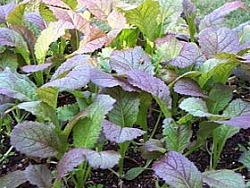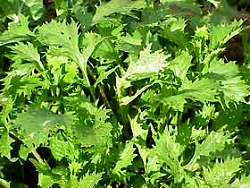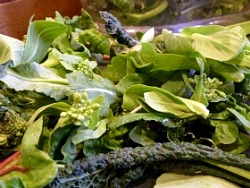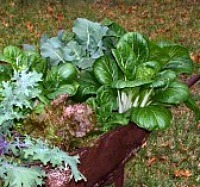Great Asian Greens

Purple leaved baby Asian greens make an attractive and spicy addition to salad mixes.

Mizuna grows quickly from seed into a serrated leaved plant with a peppery taste.
It used to be when you mentioned Asian greens most people thought of bok choi or Chinese cabbage. No more. With the explosion in interest in Asian cuisines and the growing Asian-American population in this
country, many new, unusual, and diverse Asian greens now grace our farmers’ markets, farm stands, and grocery store shelves.
The beauty of these broccoli-family relatives is they're quick and easy to grow in the garden or containers and they're very productive. You won't need much space to grow crop after crop of Asian greens in
your garden to keep you stir frying, soup stirring, and salad making all summer long. The flavors and textures vary depending on the green, from sharp and crunchy, to mild and delicate. Many greens are loaded
with vitamins and antioxidants. Plus, newer varieties offer the added advantage of beauty to the edible landscape. Red versions of bok choi and mustard look great mixed with herbs and annual flowers.
To get started with your Asian greens, you need to know the language. Unless you're of Asian descent, the names may not give you a good indication of what you're growing. To make it simple, Asian greens
can be broken down into three groups: leaf types, stem types, and flower bud types. While you can eat most parts of many Asian greens, these distinctions give you an idea of what each green is primarily
grown for. So sharpen your hoe, and let's get started sowing, growing and harvesting greens.
Leaf Types
The leaf-types are probably the most diverse of the Asian greens. Many can be grown to maturity to be used in stir fries and soups or picked young as baby greens for salad mixes. Mustards dominate this group with green and red leaf versions available. 'Osaka Purple' and 'Red Giant' are two varieties to grow that both look and taste better when allowed to be touched by cold weather.
But leaf types come in many shapes and sizes. Mizuna features sharply serrated leaves in green or purple colors. Mizuna greens offer a lightly peppery addition to salad mixes. Mibuna is similar in name only to mizuna. It features spoon-shaped rosettes of leaves that are great in salads. Another common rosette-shaped green is tat soi. This one has thicker leaves, making it a great addition to soups. For something completely different, how about an edible chrysanthemum? Shungiku is best harvested at the 4 to 8 inch tall stage and used in salads or sauteed with other vegetables. You can even eat the yellow and orange colored flowers as well.
Stem Types

Mix Asian greens in with other lettuce and milder flavored greens to create your own unique tasting salad.

Bok choi can be used in stir fries, soups, or sautees. The mild flavored, crunchy stems are even good used in dips.
The stem-type Asian greens are dominated by two types: Chinese cabbages and bok choi. Chinese or Napa cabbages feature barrel-shaped heads with tightly packed, lettuce-like leaves. 'Minuet' and 'Lettucy' are two Napa type varieties. They are great shredded into salads or chopped and used in soups or stir fries.
Bok choi (or pak choi or pac choi) varieties feature thick, white, succulent stems and dark green leaves. 'Joi choi' and 'Mei Ching Choi' are two common bok choi varieties. Newer varieties feature smaller,
single serving sized plants and better bolt resistance in the heat.
'Red Choi' has red colored leaves. These bok chois are commonly used cooked whole or halved in soups or stir fries. Baby bok choi can be picked young and added to salads.
Flower Bud Types
These Asian greens feature plants that you want to let go to flower. While most plants in the broccoli family turn bitter when allowed to flower, the flower bud types of Asian greens have flowers that are
meant to be eaten, buds and all. Chinese kale (choi sum, gai laan) is the most noteworthy of the flower bud types. Like the Italian broccoli raab, this vegetable is harvested with its stem, leaves, and flowers and is used in sautees and stir fries. The flavor is stronger than broccoli, but like most greens, cool weather tempers the taste. 'Green Lance' and 'Suiho' are varieties worth trying.
Growing Asian Greens
Asian greens thrive when they grow and mature during cool weather. Most are best grown directly from seed sown in the garden. Some, like Chinese cabbage, can be started indoors and transplanted out as seedlings to get a jump on the season. Asian greens are best grown in raised beds in fertile, well drained, loose soil. Amend the soil well with compost before planting, removing rocks, sticks and debris.
Begin planting a few weeks before the last frost date and continue sowing every few weeks until the weather gets too hot (above 70F). Begin planting again in late summer or early fall to mature when the temperatures are below 70F. Some Asian greens, such as mustard and gai laan, can withstand a light frost and keep producing into winter, especially if they're protected with a floating row cover.
When growing plants for baby greens, simply broadcast seed on the raised beds and harvest when plants are large enough to eat. To harvest as mature plants, sow seeds 2 inches apart in rows spaced 1 foot apart. Thin and eat until the spacing between plants is 6 to 12 inches apart. Space smaller plants, such as bok choi, closer together and larger plants, such as Chinese cabbages and gai laan, further apart.
Keep beds well watered and weeded, especially during the early stages of growth. If the leaves are pale yellow colored, foliar feed the plants with fish emulsion fertilizer. Keep an eye out for aphids.
They love these quick growing greens. Spray plants with insecticidal soap to control them. Flea beetles can eat shotgun-like holes in young leaves. Cover plants with a floating row cover to prevent this damage.
Most Asian greens can be harvested in the mature stage 30 to 50 days after seeding. If you're eating them as baby greens, you'll be harvesting about 20 days after seeding. Either cut individual plants at ground level so they can grow again (mizuna, shungiku) or harvest the whole plants (bok choi, gai laan). Any leftover greens make great chicken feed for your or the neighbor's birds.
Views: 6
© 2025 Created by Aggie.
Powered by
![]()